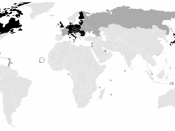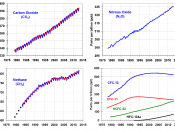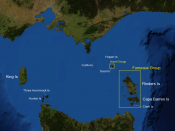IntroductionKing Island is a small island with a big industry, its products known worldwide. But, exactly how sustainable are the industries that exist on this distinctive island? This research piece will explore the sustainability of King Islands industries, in particular the kelp industry. The Kelp Industry is a highly sustainable industry in the three areas of sustainability, however there is concerns over issues beyond our control, climate change.
Background information on King IslandAs figure one shows King Island is located in the western entrance Bass Strait, in between Victoria and Tasmania.
Figure one Map of Southern Australia with King Island circles(Student Memory stick handouts, 2009)King Island lies at 144 degrees longitude and 40 degrees latitude, placing in the way of the Roaring Forties making incredibly high winds of up to and over 100 kilometres per hour making it a good place for the kelp industry to flourish without damaging the environment.
King Island is a small island, with it being approximately 64 kilometres north to south and 26 kilometres east to west with a total area of 110, 000 ha. Most of which is covered in paddocks full of cows.
Climate:The Climate on King Island is a moderate to mild maritime climate with moderate to high rain fall therefore meaning good pasture growing. This is good for the industries, such as the dairy Industry. As figure two shows, Average temperature's range from 7.8 ð C in July and August to 12.6ðC in March making the climate perfect for the soil temperature of the dairy industry and owing temperatures for the kelp industry. (KINRMG, 2001)Figure 2: The average monthly temperature on King IslandSource: (Student Memory stick handouts, 2009)What is sustainability?Sustainability to keep a system maintained for the future generations. The environment, economic, communities and individual sustainability are four examples of sustainability as seen in figure three.
Figure 3: Diagram of the four types of industrySource: (Class discussion, 2009)Community:A sustainable community must contain respect and co-operation to work towards common agendas. In this type of community all members must act as a community not as individuals. We must cooperate together as a community and share our knowledge and labour to work towards common goal of sustainability.
Environmental:Without a healthy environment, communities cannot function successfully and industry will be affected as their source of resources depletes and reduces in efficiency. Need to tackle this on a local level and model this for other's in the community to encourage them to do the same. If we act locally, the global problems will and supply be solved.
Economic:The economy relies on the community to function successfully and supply workers and a people with spending power. A successful economy requires a suitable environment which can supply a sustainable resource to process or use. The industries need to run so as to put money back into the local economy and not send it away, the latter does not make for a sustainable community and local economy.
Individual:People need to sustain themselves emotionally, physically and mentally (Class discussion, 2009)King Islands IndustriesKing Island shows just how much a small community relies on it's industry. The majority of industry is in the agricultural sector, only a small number of this is in fishing. Other major employment sectors are in retail, health and manufacturing. Some examples of jobs in retail include check outing at the Currie Supermarkets or at the Grassy Supermarket. As for Health there are jobs at the local hospital and finally for manufacturing there is the dairy factory and the kelp factory.
Dairy farming is crucial to the King Island economy, it takes up three and a half thousand hectares of land and employs 73 people, and there are approximately 6638 dairy cows on the island. The products that the cows produce are put under the King Island logo, and, are exported worldwide.
Cows also provides King island with a beef industry; there are 75 - 80 thousand head of beef cattle on the island with 80% being for beef. (KINRMG)The focus of this research piece will be on the kelp industry, a model of how much the community relies on industries.
Why is sustainability important to King Island?The question arises; why is sustainability so important for King Island? Well the answer comes down to the marketing of their products known as the 'clean green image'. King Island advertises their products on being a clean green, pollution free products. The survival of the economy relies on keeping the island's clean green image, avoiding pollution at all costs. The island has found many ways of keeping this clean green image, one of which trying to align the Island with the Kyoto Protocol. This means taking extra precautions to protect the environment. One of which is in order to protect the dairy farms. The local council has put a ban on timber plantations to protect the flourishing industry from any harm, other industries have also been affected by the councils extra precautions. The Scheelite mines has been made to attempt to Mines cover for 100% of the Greenhouse gas emissions have to plant trees in order to compensate for all the Greenhouse gases they emit whilst mining. The island is exploring other options for power including; wave power Ocean Links, solar power getting rid of the diesel power. An example of the powerful marketing edge the island has traces all the way back into Europe. In Europe, 'Cloud juice', King Island rain water sold for $20 a bottle known as, "the cleanest water in the world".(Nettlefold, 2007)If an industry collapsed the island would be left a catastrophic messFor example; one of the abattoir's closed that left 100 people jobless. Then the next day 20 people left island to go find jobs on the main land. That made the crèche lose two jobs because the quota of children is six and some of the kids left (Class discussion, 2009)Imagine if a major industry collapsed, the islands population would decrease dramatically leaving the little amount of jobs left pointless. That's why the clean green image of the island is so important; it keeps the products competitive at an international level.
Background information of Kelp and it's IndustryKelp is seaweed that is large and brown that is rich in vitamins, minerals and a substance called alginates. The company that collects the kelp is called Kelp Industries located in Currie. Because of the high winds and cold waters kelp has perfect growing conditions. (Crisp, 2006) It can only be collected off the beach after a storm, because the kelp is washed up following a storm making King Island the perfect place to make a kelp industry.(Kelp Industries Pty Ltd, 2008)Alginates are used in many everyday products; sauces, syrups, creams, lotions Mac Donalds Apple Pie and ice cream, mainly as a thickener or to get consistency within products. (Seaweed Fishery, 2008)Alginates are also sold to many cosmetics companies because of its therapeutic qualities. (Hiscots, 2009)The kelp industry isn't just restricted to things for human's bodies, but is also used on the garden as it is sold to companies such as Multicrop and Seasol.
History of the Kelp Industry on King Island.
1971-Jim Luck (Tasmanian Alginates) made contact with the London Company Alginate Industries Ltd (AIL) regarding the supply of Tasmanian Bull Kelp. (Kelp Industries Pty Ltd, 2008)1973-The first trip too evaluate the possibility of using the kelp (Kelp Industries Pty Ltd, 2008)-Jim Luck had a meeting in Scotland it was decided the company would be formed (Kelp Industries Pty Ltd, 2008)1974-The first seaweed drying process was over a barb wire fence (Kelp Industries Pty Ltd, 2008)-Mid year, the factory was in progress with a mill made from limestone and a kiln made from old power poles (Kelp Industries Pty Ltd, 2008)-They decided on building a proper factory (Kelp Industries Pty Ltd, 2008)1975-The Factory site was purchased (Kelp Industries Pty Ltd, 2008)-The company Kelp Industries was established (Kelp Industries Pty Ltd, 2008)1976-Te factory decided to build another kiln due to restricted harvesting space (Kelp Industries Pty Ltd, 2008)-The Kelp Harvesters association was formed (Kelp Industries Pty Ltd, 2008)1977-Drying racks expanded the milling system and the factory extended-The factory was burnt down at an expense of $ 100, 000-The factory was rebuilt within three weeks and was up and running in 6 weeks (Kelp Industries Pty Ltd, 2008)How sustainable is the Kelp Industry?EnvironmentalThe environmental sustainability of the kelp industry is often questioned but in fact it is actually helping the environment. They have put in place many precautions to keep the environment healthy such as not taking all of the kelp, there's still kelp left for animals to grow in. By taking away some of the kelp it is not only removing the stench it puts out but helping the birds get food by opening up the kelp sources, this leaving the bugs out in the open for the birds to feed on.
Figure 5: Kelp on the beachSource: AuthorAs figure five shows, the kelp is washed up on the beach is then dragged up from the beach therefore not affecting the growth of the kelp, because it is already dead. People drive on the roads around the beach, not on the beach so the natural environment isn't affected by the vehicles. (Hiscots, 2009)Use as much renewable energy sources as possible; wind and solar. On a windy day the renewable energy power usage could be up to 70%. This is keeping the carbon emissions to a minimum. When drying, the first stage is to hang sea weed up on racks saving on power as shown in figure 6. The wood is then dried for three years before it I burnt to keep the efficiency of the final drying process as high as possible an example of a wood stage box is shown in figure seven.
Figure 6, Seaweed hanging on the racks as the first part of the drying processSource: Author, 2009Figure 7 Wood kept in storage ready to be burntSource: Author, 2009Despite all these factors, the effect of Climate change and the growth of kelp is unknown. John Hiscots believes that Climate change is currently not affecting the King Island Kelp Industry, but, in the future it may affect the industry. How it will affect remains a mystery to him. But the people at Kelp Industries say that Climate change is already negatively affecting the kelp industry.
EconomicKing Island kelp has a higher level of alginates than other brown sea weeds 40% to 20 % as shown in figure eight, making it a really valuable resource on a world scale, keeping the demand high making it an economically sustainable business. There is also "no competition" in the market with King Island dominating it. There is only two other sources of high quality Kelp, in South America and Iceland leaving little room for competition. As figure nine shows, the world heavily relies on the King Island kelp industries as it supplies more than a quarter of the world's kelp resources making it a highly valuable industry.
Figure 8 Percentage of Alginates; King Island Kelp vs. Other Brown seaweeds, 2009 (Hiscots, 2009)Figure 9; King Island kelps use in Kelp Industries in relation to the rest of the worldSource: (Hiscots, 2009)The costs involved with the Kelp Industry are varied ranging from electricity bills to road maintenance expenses. Kelp Industries on King Island only have access to one power source, so the power is quite expensive. The cost is at 23 cents per unit, most companies on the mainland of Australia get a discounted price but on King Island everybody pays the same price. Despite the large electricity bills the Global Financial Crisis isn't having an effect on the industry and won't. Harvesters payed $504.00 per dry tonne, but to collect a dry tonne you would have to collect a hefty six tonne of wet kelp. Currently there are fifty employee's who work off of the knowledge that one pole of kelp is approximately worth twenty dollars. Kelp Industries also help with the maintenance of the roads that the kelp harvesters use; maintenance of the roads costs $20,000 per year. (Hiscots, 2009)Kelp is sold through out King Island in many forms; The Grassy Kelp Art shop sells surprisingly strong Kelp art, Peta and Dennis Klumpp sells Kelp pickles, kelp lemon spread and kelp chutney (Crisp, 2006)The Global financial crisis is currently not affecting the kelp Industry according to John Hiscots. This is because that King Island Kelp is so valuable and there is no competition within the industry. Because the alginates in kelp are used in food products it just adds to the economic stability of the industry, because food is a virtue to society. (Hiscots, 2009)Community/PersonalLife as a Kelp harvester is pretty relaxed. You get to choose your own hours, can earn as little or as much as you want and can do something fun while earning some money. Having he opportunity to choose your own hours is good for your social life because people have the flexibility to work when they want to. People get the opportunity to get some exercise while they're working to contribute to the world wide obesity crisis; Australia now officially being 'the fattest country in the world'.
The Kelp industry brings population into King Island, which is always a good thing with such a small population. Figure ten shows the number of people working in different industries; as you can see out of the selected industries Kelp has the most amounts of employees with 52 in total. (Student Memory stick handouts, 2009)Making it a communally sustainable industry because it employs a large amount of people. One o the benefits or the community is that it cleans some of the excess kelp off of the beaches, that formally made the whole island constantly stink of Kelp.
Figure 10 Employment numbers of Kelp vs. other industriesSource: (Student Memory stick handouts, 2009)Figure 11 Wet Kelp in comparison to dry kelpSource: (Hiscots, 2009)As figue eleven shows; it takes six tonnes of wet kelp to make one tonne of dry kelp. This can hinder the motovation on a personal level because it takes so much effort just to collect one dry tonne but opposing this point that the workers can choose their own hours and earn as little or as much as they want.
Population decline would have a dramatic effect on the King Island Industries. Because the population is so small every person plays a vital part in the King island Industry.
Interdependence of IndustriesAll the industries rely on each other to keep up and running because if one of the industries failed the other industries would be struggling to get money because of the mass drop in population.
If the kelp industry went broke, a lot of people would lose their second job, leaving them with less. money to send their kids to boarding school or not be able to put as much money in the economy. This would probably result in the people who have lost their jobs to leave the island.
When the abattoir closed down the next day, five people left the island because they were one of the hundred people to lose their job, this affected the crèche because the quota of kids dropped and this left another two workers jobless (Class discussion, 2009)In such a small community a slight change to the industry and it can potentially ruin lives. If one of the industries collapsed all of the industries would collapse due to population decreases and the price of things increases then more people will leave and the whole island will be let a catastrophic mess.
ConclusionThe King Island kelp industry has been shown to be a very sustainable industry. Environmentally, the industry shows that it is actually helping the native bird life get feed. The kelp it's self is dead when it is picked up so the kelp growth isn't being effected by humans. Despite the controllable measures of sustainability the question of climate change is a factor that may affect the future of the King Island kelp industry. The economic sustainability of the Kelp industry is probably the most sustainable out of the three aspects of sustainability due to the fact that the quality and quantity of the kelp on King Island is literally the best in the world. Because Kelp is essential or many foods, kelp will never be not needed. King Islands Kelp industry is personally sustainable because the workers can change their working hours depending on their social life, so they can sustain their social lives. They can also maintain a healthy body by being able to exercise whilst working. The only hindrance to the personal sustainability of the kelp industry is the amount of wet kelp you need to collect to get.
Climate change is the only main concern over the kelp industry, it is one of the many things humans cannot control and cannot be certain over what will happen in the future. Climate change could potentially stop the world's kelp industry.
The kelp industry is only just a model for all of the industries on King Island, if one of the industries fail, King Island will be left in economic turmoil. In reality all the industries are fragile on King Island because of the lack of population. If the population decreases the effects will be catastrophic as aforementioned.
This research piece has had several limitations such as time constraints and sources, therefore not making it a definitive research piece. Further studies would need to be done over the effects of climate change on the kelp industry.
BibliographyCrisp Lyndall, 2006, The Australian Financial Review, King Island Responds to a global call for kelp.
The information received from this article is general information about the king island kelp industry. This source is reliable because it is from a well known newspaper.
Dairy Business of the Year award (DBOTYA), King Island Courier, 2007This contained information regarding methods to keep the farm sustainable. This is a reliable source because it is a well known newspaperGlobal learning (Class discussion, 2009), Global learning class, King Island.
Information received was general information on sustainability. This is a reliable source because Mrs Barlow has lived on the island for three years and has had the chance to have interactions with the localsHiscots, John (2009) (Personal communication) King Island, 18/5.
John Hiscots supplied information regarding the kelp Industry and the sustainability of it. This is a reliable source because he's lived on the island for his entire life .
http://www.florahealth.com/flora/home/Canada/HealthInformation/Encyclopedias/Kelp.htm 28th August 2008Information received from this source is general information regarding kelp. The reliability of this source is questionable but the information received has been backed up by John HiscotsKelp Industries Pty Ltd http://www.kelpind.com.au/index.html 28th of August, 2008Information received from this source is the history of the kelp industry from this source. This is reliable because it one of the main kelp companies in the world and it has recorded all of the history.
King Island Natural Resource Management Group (KINRMG), 2001, KINRM Review & Strategic Action Plan.
Information received from this source is general information about King Island. This is a reliable source because it is set up by a government group.
Nettlefold, Joyclenn, 7:30 report ABC TV, 2007Information received from this source is the importance of sustainability to King Islands Industries. This is a semi- reliable source because it is a news program and it can become opinionated.
(Student Memory stick handouts, 2009), Global Learning Class, King Island.
A map was obtained by this source. This is a reliable source for a map because the map confirms with other maps on King IslandSea Fishing and Aquaculture, Department of Primary Industries and Water, (Seaweed Fishery, 2008)Information regarding the general practices on the kelp industry was obtained from this source.
Strickland, Gary (2009) (personal communication) King IslandInformation received from Gary was information regarding the dairy industry and the lifestyle of a dairy farmer. This is a reliable source because Gary has lived on the island for his whole live has studied at university.





